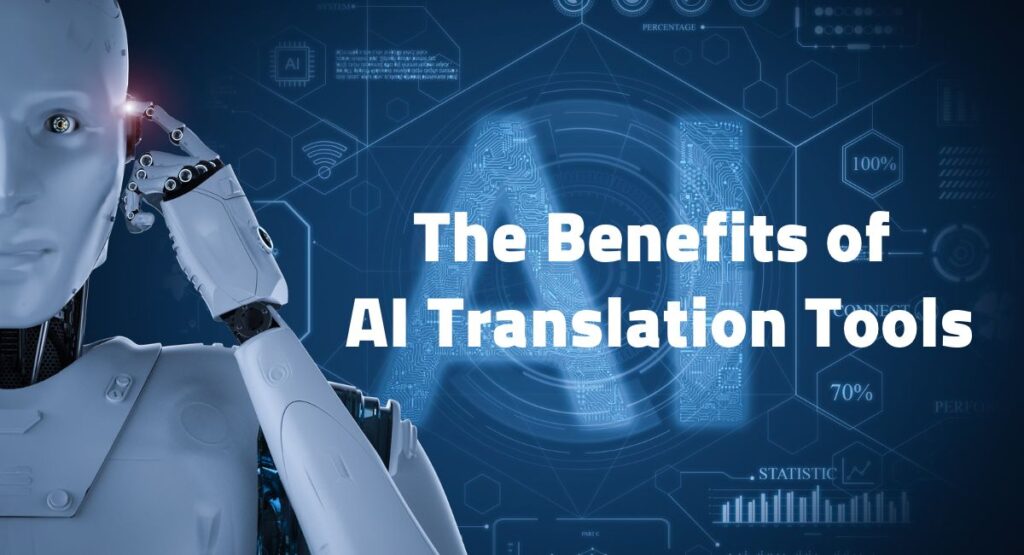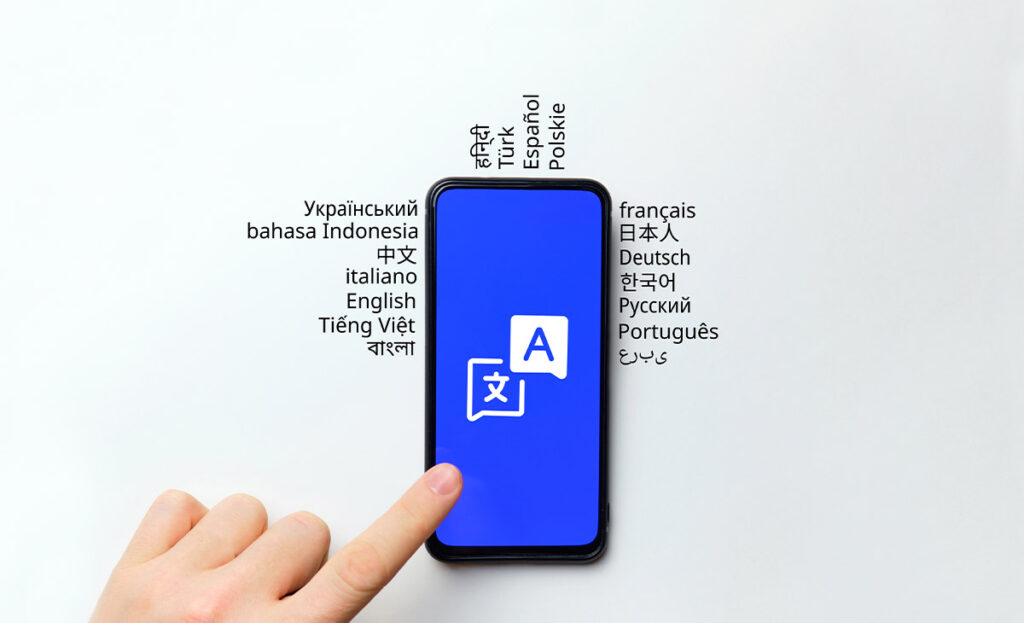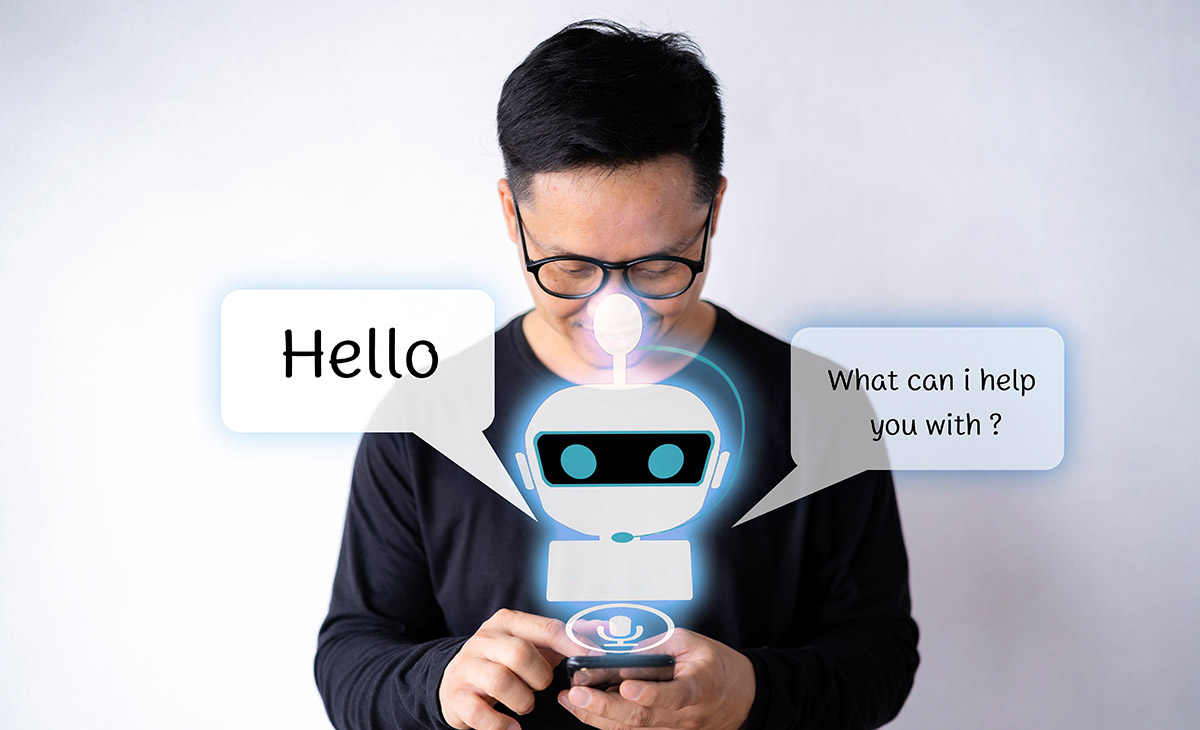Artificial intelligence become a global phenomenon in the last few months. So you could say that we’re in the midst of an AI revolution, even regarding translation work.
AI (Artificial Intelligence) is a branch of computer science that is concerned with machine intelligence and machine learning. Some of the work AI does includes speech recognition, computer vision, translation from one language into another, and more. AI is used in systems such as YouTube, Netflix, Siri & Alexa, self-driving cars, generative and creative tools (such as ChatGTP and AI art apps), and much more.
Artificial intelligence now has the ability to enter into human communications, too. AI systems, such as machines and software, can take in massive amounts of data, quickly sort it, translate it, and more. AI systems can deal with grammar and vocabulary quite effectively. They are so effective that studies have shown AI has been determined to be better than the human brain in these areas of language. Even so, AI is still a valuable tool in professional translation.
Table of Contents
Understanding AI Translators
Digital tools, called AI translators, employ artificial intelligence to translate human language. The software or machines can translate written or spoken words, but they also have the ability to translate the meaning of a message. This makes AI translators highly accurate, with fewer mistakes or misunderstandings than using only machine learning.
These artificial intelligence translators are extremely effective. Their work is more advanced than standard machine translation. Machine translation translates each word separately, which can lead to mistakes and misunderstandings.
On the other hand, AI tools understand entire phrases, tones of voice, and complicated sentence structures. Some can also understand idioms, jokes, and slang. The result of AI translations is content that’s customized for the target market.
The tools use a technology called Neural Machine translation (NMT), created by Google. NMT mimics the same approach to learning a new language as humans have. The tools analyze patterns in language based on extensive databases in the source and target languages. The data is used by NMT systems to generate codes that virtually map every word and phrase into the target language.
Neural learning systems are highly accurate, almost to the point of fluency.
Related Post : AI Translations vs Human Translation
The Benefits of AI Translation Tools

The best AI translator tools bring several significant benefits, including the following:
Speed: AI translation tools create instant translations for travelers when needed. The translators can understand menus written in foreign languages, read street signs, and more.
Support: AI translators are fast and offer almost instantaneous feedback for content writers. They can also analyze vast amounts of content and offer feedback on batch translations. AI translators also flag issues such as tone of voice that older machine learning tools could not catch.
Enhanced accuracy: AI translators tend to be more accurate than human translators.
Adaptability: AI translation software is extremely flexible and can be used to support a wide range of languages and dialects.
Improved quality control: artificial intelligence translation tools also provide better quality control; they can automatically find errors and fix them, improving quality control.
Cost-effective tools: AI language tools can deal with large amounts of text with high accuracy rates. The result is lower costs for translation agencies and for their customers. Human translators are not able to provide this amount of work quickly. In addition, there’s no need to pay human translators when AI translation tools can do the work.
Translate hundreds of languages: some of the best AI translator tools can translate hundreds of languages. Some can also translate/write into multiple languages in only a few moments.
AI translation tools are amazing in the amount of work they can handle and the accuracy they provide. In the following section, we’ll discuss some of the top AI translators available now.
Top AI Translators

Here’s our list of the top AI translation tools. We’ll discuss the features, pros, and more of each one.
Google Translate

Google Translate is the most popular translation tool around the globe. This tool offers several features, including:
- Machine translation
- Transcription
- Spell checking
- Translation into multiple languages in the cloud and across mobile devices
- And more
The tool also offers instance camera translation, which allows users to point their smartphone’s camera at foreign language text to receive instant translations. You can also upload photos of text to be translated.
Google Translate also offers a phrasebook that allows you to store words and phrases for later review. The tool can translate up to 133 languages.
Google Translate is a free translation tool, and it provides fast translations when you need them. Its best use is for tourists and others who need fast translation of signs, menus, or conversations (such as getting directions), and more.
DeepL

Next on our list is DeepL, another AI translation software. This is a highly popular tool that’s appreciated for its accuracy and tone of voice. The tool has a user-friendly interface that allows integration with Windows and iOS.
This is a great tool that offers high-quality translations; however, it does sometimes make mistakes and results that are not accurate. In addition, the tool does not offer customization options.
Even so, DeepL can translate 26 languages, and it’s best to use for document translation, app integration, website translation widget, and encrypted cloud storage.
Microsoft Translator

Microsoft Translator is next on our list of top AI translators. This powerful tool can be used in Bing (Microsoft’s browser), Office, PC apps, and phones. This AI translation tool offers the following functions on the desktop version and the mobile app:
- Text and speed translation
- Translation of photos and screenshots
- Phrasebook
- Translation of conversations across devices
Microsoft Translator supports more than 70 languages; however, not all languages have the same functions. This AI tool can translate the following languages:
- English
- German
- Spanish
- Arabic
- Hebrew
- Japanese
- And more
The app is fairly easy to use and the longer the text, the more accurate the translation will be. This app needs more context to provide better translations.
Microsoft Translator is best used by those who need a fast, accurate translation. However, the language pairs that are most common provide the best results. It makes a great translation tool for travelers and anyone who needs to have a fast, simple conversation with another person.
OpenAI’s ChatGPT

An organization called OpenAI has created one of the most famous AI tools called ChatGPT. ChatGPT is a conversational chatbot that was designed to engage humans in human-like conversations. This AI tool is a chatbot that’s connected to a massive database. You can use the tool to ask questions and obtain data; however, the tool can also be used to translate.
To use this tool, it’s necessary for the user to input text and ask the AI to translate the text, specifying the output language. ChatGPT is not able to translate a live conversation, pictures, menus, or signs. You must type in the text first.
The AI tries to understand the meaning behind the text and then does the translation. However, the tool is more like predictive text—it uses an algorithm to guess what word will be used next. ChatGPT relies on the input in its database and what the user has input. This can lead to good translations; however, there’s also a high level of inaccuracy when using this AI tool for translations.
Google’s Multilingual Universal Sentence Encoder (MUSE) (also known as Google’s BERT)
Is ChatGPT a Translation Tool?
Currently, ChatGPT is a text-only AI tool. It needs users to input a text prompt and then the AI can generate a text response. The tool can be used for translation; however, its accuracy is highly dependent on the user’s input. This tool uses predictive text to determine (guess) what the next word will be.
In addition, ChatGPT is not able to properly localize translations. Here, the user or human translator much check the work to ensure it’s properly translated and localized to the target audience.
Even so, ChatGPT can be used for simple translation tasks, but we strongly recommend having a human ensure the translation is accurate and localization is correct.
Reliability of Google BERT (Bard) in Translation
Explore the effectiveness of Google’s BERT model in translation tasks. Discuss its strengths and weaknesses and how it compares to other AI translation tools in terms of reliability and accuracy.
AI Translation vs. Professional Translation Services
Many people ask if AI translators will take over professional translation services. It’s our opinion that no, AI will not replace human translators. The main issue is that machines are not able to understand the nuances in each language when it comes to grammar, semantics, cultural sensitivities, and more.
While AI translation tools can deal with large amounts of data, create fast translations, and more, human translators are still essential to the translation process. Professional translations, such as Pollion, have the knowledge, expertise, and understanding of the cultural sensitivities of the languages they work with.
Professional translators, for instance, can translate a text and ensure it contains no offensive language, idioms, jokes, and more. They can also determine whether images are properly localized for the target audience. These are crucial tasks that must be done by human translators. AI translators are not yet capable of performing this work. In addition, professional human translators are also more accurate.
AI translation tools are excellent when you need a fast translation, have internal business documents that must be translated into multiple languages, and even for traveling. However, when it comes to specialized content, a human translator is always the best option.
Sure, the costs of dealing with a human translator are higher than using AI translation tools. However, you can rest assured that the professional human translator will catch errors, miscommunications, localization issues, and more that the AI tools are not able to catch.
We believe the combination of AI translators and professional human translators, such as Pollion, is best. The two working together provide the fastest, more cost-effective, accurate translations available today.
Debate the advantages and disadvantages of AI translation tools compared to professional translation services. Consider factors such as cost, speed, accuracy, cultural nuance, and the nature of the text to be translated. Discuss in which scenarios one might be preferred over the other and whether a combination of both could provide the best results in certain situations.
Q: Will AI replace translators?
Comparison of Features
Here’s a quick overview of AI translators and their features, pricing, and more.
| Features | Google Translate | DeepL | Microsoft Translator | OpenAI’s ChatGPT |
| Translation Accuracy | Accuracy depends on the language pairs used/the more common the language pairs, the higher the accuracy rates. | Has a good reputation for providing highly accurate translations | Also has a good reputation for being accurate and is faster than some other AI translation tools | Has earned a reputation for providing highly accurate translations |
| Number of Supported Languages | 133 | 31 | 100 + | 50+ |
| Interface/apps/API Integrations | WebsiteMobile app (Android & iOS)API | WebsiteAPI | APIMobile App (Android & iOS) | Website |
| Ease of Use | Easy | Easy | Easy | Somewhat easy |
| Pricing | Free for personal use | Starts out free; offers tiered pricing starting at £7.49/mo and up | Starts out free with up to 2M characters of standard translation, then offers tiered pricing plans from there | Offers free version and paid version at $20/mo. |
Use Cases for AI Translators
AI translators are very useful translation tools, especially in the following use cases.
Internal Communications
Multinational companies with employees scattered around the world can make excellent use of AI translation tools. In this case, the tools are especially effective at sending out internal company communications across multiple languages.
External Communications
The same multinationals can also effectively use AI translation tools for external communications. For instance, the company may want to reach various target audiences with videos, blog posts, and other materials. AI translation tools provide fast, accurate translations for these uses.
Language Learning
AI translation tools can also be used by students learning another language. Tools, such as Google Translate and ChatGPT, among others, can be used to learn a new language. However, you should not rely only on these tools. They’re great for learning new words and phrases, but the tools are not a replacement for working with a language teacher or a language learning program. AI translation tools may be unable to teach you pronunciation, grammar, slang, and other expressions.
When AI translators are used in combination with teachers and learning programs, they can be helpful tools for learning other languages.
Travel
AI translators are also excellent tools for travelers, especially Google Translate. Google Translate can translate live conversations, text on pictures, menus, and more. And this specific tool is free to use on a wide range of devices, making this one of the best choices for travelers who need language translation on their trips.
Limitations of AI Translators
While AI translation tools can be extremely beneficial, they also come with certain limitations.
Poor Accuracy
Many AI translation tools produce inaccurate translations. They lack the experience, knowledge, and understanding of languages that a professional linguist has to offer. The result can be misunderstandings, miscommunications, and confusion for those relying on these AI tools.
Lack of Cultural Sensitivity
Another problem with AI translation tools is that they usually lack cultural sensitivity. Some of these tools may also make offensive, incorrect statements. The tools are not able to localize the content like a professional translator.
AI translation tools have not yet learned to understand all the nuances of a culture or its language. The resulting translations could cause great offense in some instances.
Data Protection & Privacy Problems
AI translation tools take in mountains of data that are collected from users and the Internet. The problem here is that many of these tools lack data protection and privacy regulations. The companies offering these services can then gather any data from users.
Without proper regulation, AI tools are not recommended for use with confidential information, such as company data or personal data.
These are a few of the main issues and limitations of AI translators. The good news is that the technologies continue to advance and evolve, so in the future, these limitations may be overcome.
Future of AI Translators
AI translators come with many benefits and limitations; however, it’s our opinion that AI will not completely replace human translators. The AI translation tools, at the current time, are too prone to mistakes and errors. Plus, they lack the ability to understand the nuances of human languages. Human translators will always be the best translators.
However, using AI translation tools in combination with human translators may be the best option for now. AI translators handle vast amounts of data and can turn out translations quickly. Once the AI has finished its work, the human translator can come in and finish the translation. Here, it’s the professional translator’s job to ensure the translation is accurate and localization has also been added.
Professional translation agencies, such as Pollion, working together with AI translators is the best of both worlds, at least for now.
The future for AI translators looks bright as the technology continues to advance.
Read also:
- AI Translations vs Human Translation
- The Role of ChatGPT in the Future of Business
- Unveiling the Potential of OpenAI’s ChatGPT
Conclusion
The need for translations continues to grow in our globalized world, making AI translators necessary. AI translators can deal with massive amounts of data and quickly turn out a very good translation.
Even so, human translators are needed to ensure the content has been appropriately translated and localized to the target audience.
The best combination is for humans to work with AI translators to deal with the growing need for translation work in our ever-more digitized world.
